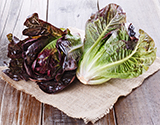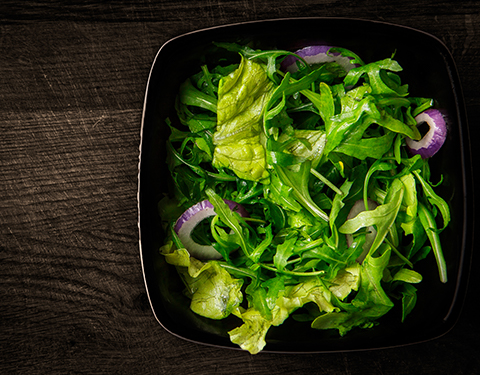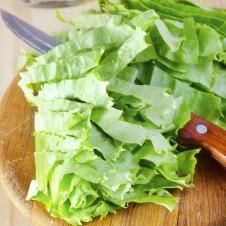Lettuce
Maybe people don't think a lot about lettuce, but it's a staple for almost every restaurant. Whether it's salads, sandwiches, garnishes or a carrier, the type of lettuce you use is important. Learn more about the types of lettuce and how to make informed purchases.
Before purchasing, discover everything you need to know about popular lettuce varieties, grades and standards, and storage and handling.
Before purchasing, discover everything you need to know about popular lettuce varieties, grades and standards, and storage and handling.
Page contents:
Popular Lettuce Varieties | Lettuce Grades and Standards | Lettuce Storage and Handling
Popular Lettuce Varieties
| Variety | Primary Applications and Attributes | |
|---|---|---|
| Iceberg | Round in shape, typically large and moderately firm heads, thick crisp leaves medium to light green in color. Best used for salads, sandwiches, garnish and wedges. |  |
| Romaine | Fairly large and elongated "heads" with thick leaves, dark green outer leaves and light green inner leaves. Best used for Caesar and other salads, sandwiches, garnish, lettuce wraps. |  |
| Red/Green Leaf | Fairly large, loose leaves that are curly. Green leaf is medium to dark green in color. Red leaf ends are medium to dark red, while coloring beneath the ends is medium to dark green in color. Both varieties are best used for salads, sandwiches and garnish. |  |
| Spinach | Broad, thick, crisp leaves with both leaves, and stems being dark green in color. The two primary varieties are flat and curly (savoy). Flat leaf is more tender, with smaller stems that may not need to be removed. Best used for salads, sandwiches, pasta dishes, soups, quiches and side dishes. |  |
| Salad Blends | Include multiple lettuce or greens varieties that range in leaf size, color, shape and texture. Many benefits including ready-to-use, no waste, consistent weights and yields. Best used for salads or sandwiches/wraps. |  |
LETTUCE GRADES AND STANDARDS
The two most common USDA grades used in the foodservice industry are U.S. No. 1 and U.S. No. 2.
U.S. No. 1 lettuce must meet the following requirements:
- Similar varietal characteristics
- Fresh, green, not soft, not burst
- Free from decay and doubles
- Not damaged by any other cause
- Each head fairly well-trimmed, unless specified as closely trimmed
U.S. No. 2 Lettuce Must Meet the Following Requirements:
- Similar varietal characteristics
- Not burst
- Free from decay
- Not seriously damaged by any other cause
- Unless otherwise specified, each head should be reasonably trimmed
Source: U.S. Department of Agriculture
Lettuce Storage and Handling
Storage
Storage plays an important role in the quality of lettuce.
- Optimum Storage Temperatures: as close to 33°F as possible; in the blue zone of the cooler
- Relative humidity of 98–100% with some air circulation
- Do not freeze; no direct contact with ice
- Do not store in dry storage areas
- Store away from ethylene gas-producing products like apples, grapes and berries
Optimum Handling for
Whole Head/Commodity Lettuce
- Avoid using leafy greens with visible signs of decay or damage
- Strip outer coarse leaves from heads prior to washing
- Wash lettuce just prior to serving under cold, running water. Do not immerse or soak in water
- Separate the leaves during washing to remove sand and debris

